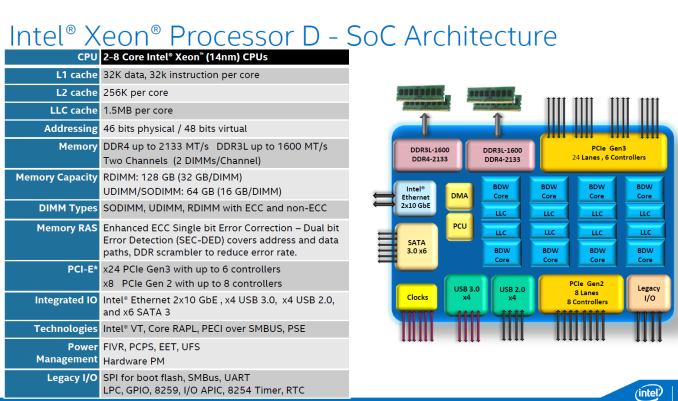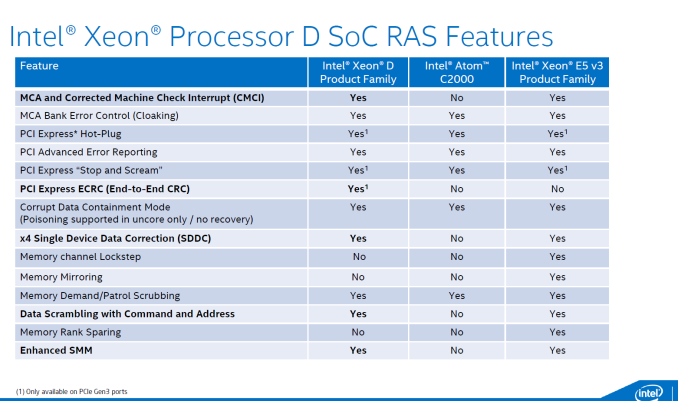The Intel Xeon D Review: Performance Per Watt Server SoC Champion?
by Johan De Gelas on June 23, 2015 8:35 AM EST- Posted in
- CPUs
- Intel
- Xeon-D
- Broadwell-DE
Broadwell in a Server SoC
In a nutshell, the Xeon D-1540 is two silicon dies in one highly integrated package. Eight 14 nm Broadwell cores, a shared L3-cache, a dual 10 gigabit MAC, a PCIe 3.0 root with 24 lanes find a home in the integrated SoC whereas in the same package we find four USB 3.0, four USB 2.0, six SATA3 controllers and a PCIe 2.0 root integrated in a PCH chip.
The Broadwell architecture brings small microarchitectural improvements - Intel currently claims about 5.5% higher IPC in integer processing. Other improvements include slightly lower VM exit/enter latencies, something that Intel has been improving with almost every recent generation (excluding Sandy Bridge).
Of course, if you are in the server business, you care little about all the small IPC improvements. Let us focus on the large relevant improvements. The big improvements over the Xeon E3-1200 v3 are:
- Twice as many cores and threads (8/16 vs 4/8)
- 32 GB instead of 8 GB per DIMM supported and support for DDR4-2133
- Maximum memory capacity has quadrupled (128 GB vs 32 GB)
- 24 PCIe 3.0 lanes instead of 16 PCIe 3.0 lanes
- 12 MB L3 rather than 8 MB L3
- No separate C22x chipset necessary for SATA / USB
- Dual 10 Gbit Ethernet integrated ...
And last but not least, RAS (Reliability, Availability and Servicability) features which are more similar to the Xeon E5:
The only RAS features missing in the Xeon D are the expensive ones like memory mirroring. Those RAS features a very rarely used, and The Xeon D can not offer them as it does not have a second memory controller.
Compared to the Atom C2000, the biggest improvement is the fact that the Broadwell core is vastly more advanced than the Silvermont core. That is not all:
- Atom C2000 had no L3-cache, and are thus a lot slower in situation where the cores have to sync a lot (databases)
- No support for USB 3 (Xeon D: four USB 3 controllers)
- As far as we know Atom C2000 server boards were limited to two 1 Gbit PHYs (unless you add a separate 10 GBe controller)
- No support for PCIe 3.0, "only" 16 PCIe Gen2 lanes.
There are more subtle differences of course such as using a crossbar rather than a ring, but those are beyond the scope of this review.













90 Comments
View All Comments
Krysto - Tuesday, June 23, 2015 - link
Betteridge law.Metaluna - Tuesday, June 23, 2015 - link
...fails in this case. Did you read the review?CajunArson - Tuesday, June 23, 2015 - link
While desktop Broadwell isn't all that great, these server parts really show off Intel's accomplishments in improving power efficiency and performance-per-watt with 14nm.ARM has a huge hill to climb to really compete with these parts, and we've already seen AMD effectively skip its first iteration of an ARM product because they probably got wind of the Xeon D and decided they would have to do both a die-shrink and completely customized ARM core just to keep up.
The_Assimilator - Tuesday, June 23, 2015 - link
I very much doubt whether we'll ever see another server CPU from AMD, regardless of ARM cores or not. If they even manage to get Zen out the door, *and* it's not another massive flop, I will be impressed.Refuge - Tuesday, June 23, 2015 - link
I root for them everyday, but lets not give them too big of a hill to climb with a broken leg now. lolextide - Tuesday, June 23, 2015 - link
Take it easy man, AMD is not going down the drain any time soon, and we WILL see some future server oriented parts come from them. But how fast will they be? That's the question and we wont know for a while...Kjella - Tuesday, June 23, 2015 - link
Really? Last quarter they had a $187 million total comprehensive loss on $1030 million in revenue, even if you exclude the restructuring cost they lost $100 million for a -10% deficit. The stockholder's equity is almost gone with $17 million left, after that getting funding or a credit limit will become much harder.And Q2 is probably going to be another bloody quarter with no major CPU or GPU launches and firesales of old Win8 stock in preparation for Win10. The console ramp-up is usually in Q3 in preparation for Christmas, not before the summer. Last quarter's loss they took almost entirely from their cash reserves, they're now in the lower end of what they need to operate, if they lose this quarter too they must cut where it hurts bad.
Guspaz - Tuesday, June 23, 2015 - link
When we needed a low-power and low-cost server solution, we went with a desktop i3, because for some reason Intel supports ECC RAM on the i3 and lower, but not in the i5 and higher.julianb - Tuesday, June 23, 2015 - link
Very interested in this SOC.If possible could we see how the Xeon D deal with Cinebench Multithreaded test?
I am into 3D CPU rendering and would like to know how does the Xeon D-1540 compare to say i7-3930K or i7-4790K.
I realize the purpose of Xeon D-1540's existence is different but still...
Thank you.
MrSpadge - Saturday, June 27, 2015 - link
An eco-tuned 5820K seem better. I don't suppose you're going to render 24/7 all the time, so the electricity savings from the 14 nm Broadwell will have a hard time making up for the massive difference in initial cost.